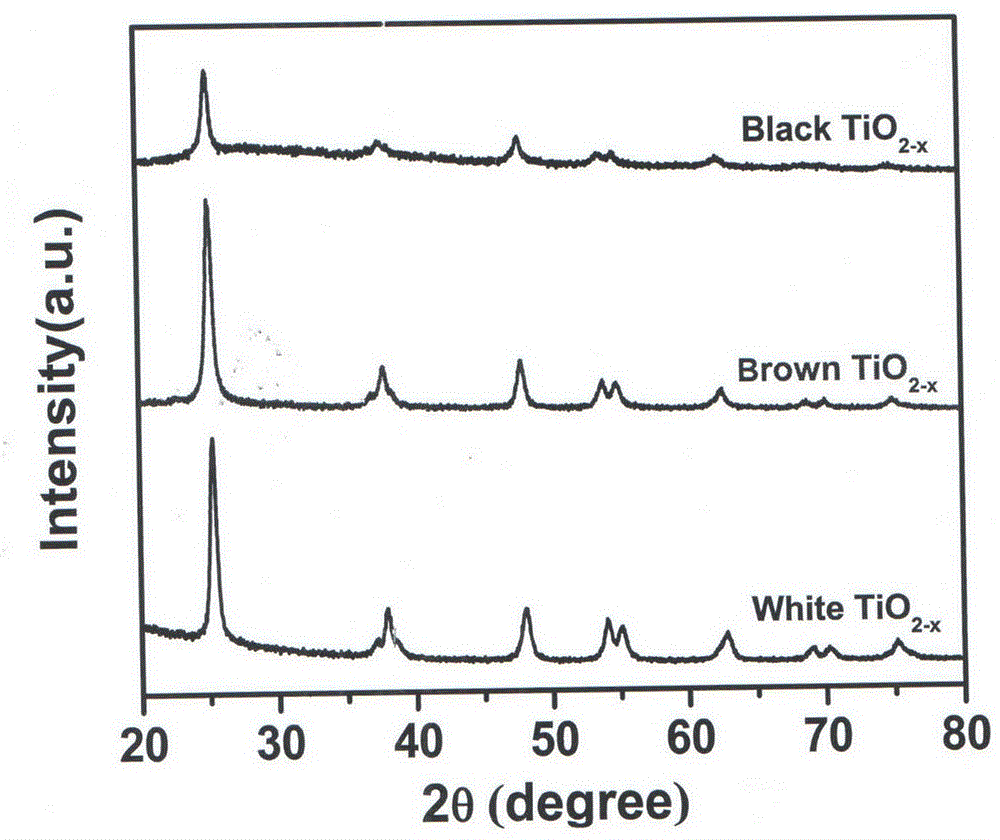Preparation method for nanometer black titanium dioxide photocatalyst
A black titanium dioxide, photocatalyst technology, applied in the field of photocatalytic materials, can solve the problem of not being able to fully utilize sunlight energy and other problems
- Summary
- Abstract
- Description
- Claims
- Application Information
AI Technical Summary
Problems solved by technology
Method used
Image
Examples
Embodiment 1
[0018] a. Add 2g of titanium trichloride and 0.1g of sodium borohydride into 20mL of deionized water, and keep stirring for 1 hour to obtain a purple transparent solution;
[0019] b. Add 0.2mol / L sodium hydroxide solution to the solution obtained in step a until the pH value is 2, and continue stirring for 2 hours to obtain a black titanium dioxide solution;
[0020] c. Transfer the solution in step b to a 100mL hydrothermal kettle, and react at a temperature of 80° C. for 4 hours to obtain nanometer black titanium dioxide;
[0021] d. Wash the nano-black titanium dioxide obtained in step c through 50 mL of deionized water and 50 mL of ethanol respectively until the pH is 7, and dry to obtain the final nano-black titanium dioxide photocatalyst.
Embodiment 2
[0023] a. Add 5g of titanium trichloride and 0.7g of ascorbic acid into 50mL of deionized water, and keep stirring for 2 hours to obtain a purple transparent solution;
[0024] b. Add 1.0 mol / L sodium hydroxide solution to the solution obtained in step a until the pH value is 5, and continue stirring for 2 hours to obtain a black titanium dioxide solution;
[0025] c. Transfer the solution in step b to a 100mL hydrothermal kettle, and react at a temperature of 180°C for 12 hours to obtain nanometer black titanium dioxide;
[0026] d. Wash the nano-black titanium dioxide obtained in step c with 50 mL of deionized water and 50 mL of ethanol respectively until the pH is 7, and dry to obtain the final nano-black titanium dioxide photocatalyst.
Embodiment 3
[0028] a. Add 8g TiOCl and 0.8g hydrazine hydrate into 70mL deionized water, and keep stirring for 3 hours to obtain a purple transparent solution;
[0029] b. Add 1.2mol / L sodium hydroxide solution to the solution obtained in step a until the pH value is 8, and continue stirring for 3 hours to obtain a black titanium dioxide solution;
[0030] c. Transfer the solution in step b to a 100mL hydrothermal kettle, and react at a temperature of 200°C for 18 hours to obtain nanometer black titanium dioxide;
[0031] d. Wash the nano-black titanium dioxide obtained in step c with 50 mL of deionized water and 50 mL of ethanol respectively until the pH is 7, and dry to obtain the final nano-black titanium dioxide photocatalyst.
PUM
 Login to View More
Login to View More Abstract
Description
Claims
Application Information
 Login to View More
Login to View More - R&D
- Intellectual Property
- Life Sciences
- Materials
- Tech Scout
- Unparalleled Data Quality
- Higher Quality Content
- 60% Fewer Hallucinations
Browse by: Latest US Patents, China's latest patents, Technical Efficacy Thesaurus, Application Domain, Technology Topic, Popular Technical Reports.
© 2025 PatSnap. All rights reserved.Legal|Privacy policy|Modern Slavery Act Transparency Statement|Sitemap|About US| Contact US: help@patsnap.com


